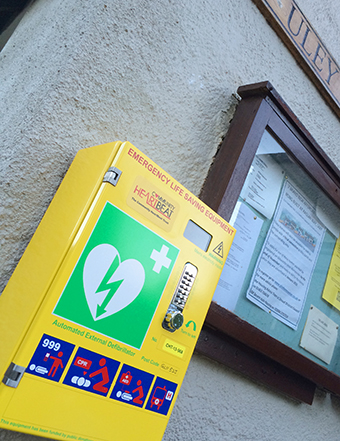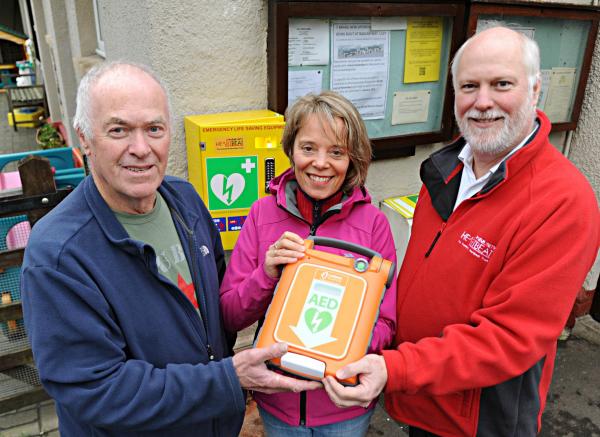Life-saving assets for our village
 Following a cardiac arrest brain death starts after 3 minutes so urgent action is needed, particularly in rural areas where it can take several minutes to get a competently trained person to the scene. Community defibrillators can save vital minutes and means a better outcome for the casualty.
Following a cardiac arrest brain death starts after 3 minutes so urgent action is needed, particularly in rural areas where it can take several minutes to get a competently trained person to the scene. Community defibrillators can save vital minutes and means a better outcome for the casualty.
Where are they?
There is one defibrillator installed at the Village Hall, and another will soon be located at the pavilion at Shadwell playing fields.
How do you use it?
If someone collapses, follow these instructions:
| DANGER | Ensure the scene is safe for yourself and others. If it is not safe and you are uncertain call 999 and wait for help to arrive |
| RESPONSE | Check the casualty needs help by stating ‘Can I help you’? in a loud voice in each ear in case the patient is deaf. Tap collar bones |
| SEND/SHOUT | If the casualty does not respond, shout for help or send someone off to get help. Do not leave the casualty on their own. Phone 999 NOW! |
| AIRWAY | Ensure the airway is Open and Clear. Open the airway by placing one hand on the forehead and two fingers under the chin and do a head tilt and chin lift. Do not put your fingers in the casualty’s mouth, you may push an obstruction further down. |
| BREATHING | Keep the head tilted back and listen for breathing. Look to see if the chest is moving. If the casualty is not breathing normally or you have any doubt, call 999. |
| COMPRESSIONS | If the casualty is not breathing, start chest compressions by placing your hands in the centre of the casualty’s chest and press down hard. For an adult compress down to 5-6 cm. Just keep doing compressions until the defib arrives or the ambulance arrives. |
| DEFIBRILLATION | Get someone to fetch a defibrillator. You will be give the access code for the defibrillator when you phone 999. The operator will stay with you on the phone and will talk you through what you need to do. To access the defibrillator from the cabinet you must always press ‘C’ first which is part of the code. This cancels all previous numbers that may have been inputted. |
Switching on the defibrillator starts the verbal instructions on its use. Pads are applied directly to the bare chest as shown on the diagram on the pads. Cut through clothing and remove any perspiration with paper towel provided. There are scissors in the cabinet.
The defib may suggest that you give 2 breaths to 30 compressions. Standard practice now is not to give breaths just keep going with compressions. If you choose to give breaths, there is a mask in the cabinet to minimise cross-infection. Please throw it away after use if you do use it.
The patient should be kept as dry as possible, not lying in water or touching anything metal.
Medication patches should be removed and jewellery moved from the chest. Pads should not be placed on any obvious medical device like a pacemaker implanted below the skin. Pad must be placed at least 2″ or 5 cm below it.
If the defib tells you to shock the patient PLEASE MAKE SURE THAT NO-ONE is touching the patient.
If told to continue with CPR do this until you are told to stop by a Paramedic, GP or you are physically unable to continue.
If the casualty starts to cough and colour starts to come back to their face plus breathing returns then put the casualty in the recovery position until the ambulance arrives.
Useful videos
This is the defib we have procured and is recommended by South West Ambulance Trust. The video shows how to use the Cardiac Science G5 defib. (Video runs for 5 mins). Our defib is semi-automatic so if required, you will be asked to press the button to administer a shock.
Shows how to put the casualty in the recovery position when they ARE BREATHING (Video runs for 2 mins)
Maintenance
The defibs will be checked weekly and reports submitted to Community Heartbeat.
Inside the cabinet is a leaflet giving guidelines similar to those above. Please return these guidelines back to the cabinet if you use the defib. You access the defib by a 5 digit code. This code will be given to you when you dial 999. The defib is in an orange box and you take it from the cabinet and when you open it, it will talk to you. If you do use the defib, then Kim Harvey will need to be contacted to put in replacement pads. The pads are for casualties who are 8 years and over. Kim’s details are noted in the cabinet.
If you live alone or as a couple you may wish to organise a ‘back up’ person so they can fetch the defib if you are unable to do so.
Thank you
We are privileged to have defibrillators in our village and enormous thanks goes to Kim Harvey for organising the campaign to raise enough money and arranging their installation and an awareness session for residents.
Generous donations were received from many local groups including the Fireworks Committee (thanks to Martin Coates and Vicki Coffey), Chas Wright of Uley Brewery, Uley Football Club, Uley Cricket Club, Uley Playing Fields Committee, Uley WI and Stroud District Council.
Special thanks go to Rod White, Treasurer of Uley Society for his support of the campaign.
Press coverage

Gazette: Determined Uley resident successfully campaigns for defibrillator in her village



